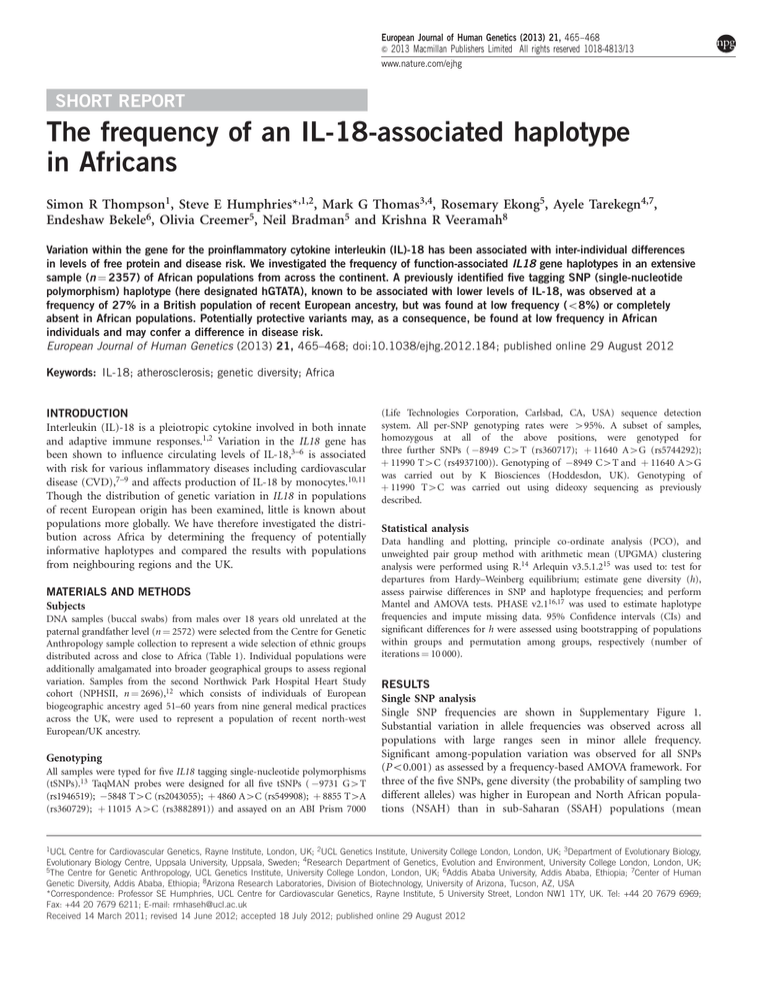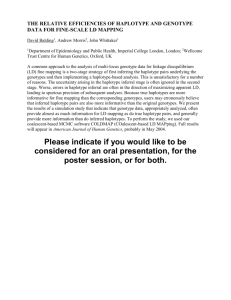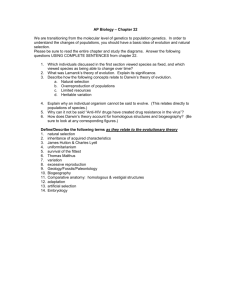
European Journal of Human Genetics (2013) 21, 465–468
& 2013 Macmillan Publishers Limited All rights reserved 1018-4813/13
www.nature.com/ejhg
SHORT REPORT
The frequency of an IL-18-associated haplotype
in Africans
Simon R Thompson1, Steve E Humphries*,1,2, Mark G Thomas3,4, Rosemary Ekong5, Ayele Tarekegn4,7,
Endeshaw Bekele6, Olivia Creemer5, Neil Bradman5 and Krishna R Veeramah8
Variation within the gene for the proinflammatory cytokine interleukin (IL)-18 has been associated with inter-individual differences
in levels of free protein and disease risk. We investigated the frequency of function-associated IL18 gene haplotypes in an extensive
sample (n ¼ 2357) of African populations from across the continent. A previously identified five tagging SNP (single-nucleotide
polymorphism) haplotype (here designated hGTATA), known to be associated with lower levels of IL-18, was observed at a
frequency of 27% in a British population of recent European ancestry, but was found at low frequency (o8%) or completely
absent in African populations. Potentially protective variants may, as a consequence, be found at low frequency in African
individuals and may confer a difference in disease risk.
European Journal of Human Genetics (2013) 21, 465–468; doi:10.1038/ejhg.2012.184; published online 29 August 2012
Keywords: IL-18; atherosclerosis; genetic diversity; Africa
INTRODUCTION
Interleukin (IL)-18 is a pleiotropic cytokine involved in both innate
and adaptive immune responses.1,2 Variation in the IL18 gene has
been shown to influence circulating levels of IL-18,3–6 is associated
with risk for various inflammatory diseases including cardiovascular
disease (CVD),7–9 and affects production of IL-18 by monocytes.10,11
Though the distribution of genetic variation in IL18 in populations
of recent European origin has been examined, little is known about
populations more globally. We have therefore investigated the distribution across Africa by determining the frequency of potentially
informative haplotypes and compared the results with populations
from neighbouring regions and the UK.
MATERIALS AND METHODS
Subjects
DNA samples (buccal swabs) from males over 18 years old unrelated at the
paternal grandfather level (n ¼ 2572) were selected from the Centre for Genetic
Anthropology sample collection to represent a wide selection of ethnic groups
distributed across and close to Africa (Table 1). Individual populations were
additionally amalgamated into broader geographical groups to assess regional
variation. Samples from the second Northwick Park Hospital Heart Study
cohort (NPHSII, n ¼ 2696),12 which consists of individuals of European
biogeographic ancestry aged 51–60 years from nine general medical practices
across the UK, were used to represent a population of recent north-west
European/UK ancestry.
Genotyping
All samples were typed for five IL18 tagging single-nucleotide polymorphisms
(tSNPs).13 TaqMAN probes were designed for all five tSNPs ( 9731 G4T
(rs1946519); 5848 T4C (rs2043055); þ 4860 A4C (rs549908); þ 8855 T4A
(rs360729); þ 11015 A4C (rs3882891)) and assayed on an ABI Prism 7000
(Life Technologies Corporation, Carlsbad, CA, USA) sequence detection
system. All per-SNP genotyping rates were 495%. A subset of samples,
homozygous at all of the above positions, were genotyped for
three further SNPs ( 8949 C4T (rs360717); þ 11640 A4G (rs5744292);
þ 11990 T4C (rs4937100)). Genotyping of 8949 C4T and þ 11640 A4G
was carried out by K Biosciences (Hoddesdon, UK). Genotyping of
þ 11990 T4C was carried out using dideoxy sequencing as previously
described.
Statistical analysis
Data handling and plotting, principle co-ordinate analysis (PCO), and
unweighted pair group method with arithmetic mean (UPGMA) clustering
analysis were performed using R.14 Arlequin v3.5.1.215 was used to: test for
departures from Hardy–Weinberg equilibrium; estimate gene diversity (h),
assess pairwise differences in SNP and haplotype frequencies; and perform
Mantel and AMOVA tests. PHASE v2.116,17 was used to estimate haplotype
frequencies and impute missing data. 95% Confidence intervals (CIs) and
significant differences for h were assessed using bootstrapping of populations
within groups and permutation among groups, respectively (number of
iterations ¼ 10 000).
RESULTS
Single SNP analysis
Single SNP frequencies are shown in Supplementary Figure 1.
Substantial variation in allele frequencies was observed across all
populations with large ranges seen in minor allele frequency.
Significant among-population variation was observed for all SNPs
(Po0.001) as assessed by a frequency-based AMOVA framework. For
three of the five SNPs, gene diversity (the probability of sampling two
different alleles) was higher in European and North African populations (NSAH) than in sub-Saharan (SSAH) populations (mean
1UCL Centre for Cardiovascular Genetics, Rayne Institute, London, UK; 2UCL Genetics Institute, University College London, London, UK; 3Department of Evolutionary Biology,
Evolutionary Biology Centre, Uppsala University, Uppsala, Sweden; 4Research Department of Genetics, Evolution and Environment, University College London, London, UK;
5The Centre for Genetic Anthropology, UCL Genetics Institute, University College London, London, UK; 6Addis Ababa University, Addis Ababa, Ethiopia; 7Center of Human
Genetic Diversity, Addis Ababa, Ethiopia; 8Arizona Research Laboratories, Division of Biotechnology, University of Arizona, Tucson, AZ, USA
*Correspondence: Professor SE Humphries, UCL Centre for Cardiovascular Genetics, Rayne Institute, 5 University Street, London NW1 1TY, UK. Tel: +44 20 7679 6969;
Fax: +44 20 7679 6211; E-mail: rmhaseh@ucl.ac.uk
Received 14 March 2011; revised 14 June 2012; accepted 18 July 2012; published online 29 August 2012
IL18 haplotype frequencies in Africa
SR Thompson et al
466
Table 1 Summary of populations used, number of individuals (n),
acronym and location
Collection location
Population
code
Description
Latitude (1) Longitude (1)
n
NSAH
EUR
AYL
NPHSII Aylesbury
51.816
0.808
113
CAM
CHE
NPHSII Camberley
NPHSII Chesterfield
51.335
53.235
0.743
1.422
373
209
HAL
HAR
NPHSII Halesworth
NPHSII Harefield
52.343
51.603
1.501
0.481
424
247
NMY
PRK
NPHSII North Mymms
NPHSII Parkstone
51.721
50.72
0.205
1.945
292
397
CAR
STA
NPHSII Carnoustie
NPHSII St Andrews
56.503
56.341
2.702
2.798
341
300
ANT
ANT
Anatolian Turks
ARB
ARB
Mixed Arabians
15.409
44.242
37
Yemeni from Hadramaut
14.544
49.127
83
Mixed Algerians
35.083
2.233
182
Moroccan Berbers
33.588
5.165
87
YEH
NAF
ALG
BBR
39.929
32.853
95
SSAH
WAF
FUL
6.477
11.551
63
MAM
SAR
Mambilla from Cameroon
Shewa Arabs
Fulani from Cameroon
6.477
12.076
11.551
15.032
96
90
BUL
IGB
Bulsa from Ghana
Igbo from Nigeria
10.726
4.957
1.279
8.314
90
100
MJK
WEA
Manjak from Senegal
Mixed West African populations
14.687
—
17.452
—
85
144
EAM
EAN
Ethiopian Amhara
Ethiopian Anuak
11.683
8.243
38.15
34.593
262
95
EOR
NSD
Ethiopian Oromo
Northern Sudanese
7.664
19.17
36.831
30.474
94
146
SSD
CEA
Southern Sudanese
Mixed East African populations
6.227
—
31.567
—
125
26
CEA
SEA
CHW
TBK
Chewa from Malawi
Tumbuka from Malawi
13.983
11.465
33.774
34.023
92
60
YAO
SEN
Yao from Malawi
Mixed Mozambiquans
14.478
15.409
35.264
44.242
56
83
BAN
LMB
Bantu speakers from South Africa
South African Lemba
26.144
20.48
28.05
29.914
107
82
SEA
Mixed Southeast African populations
—
—
192
h: 9731 (NSAH ¼ 0.476, SSAH ¼ 0.446); 5848 (0.478, 0.495);
þ 4860 (0.408, 0.251); þ 8855 (0.407, 0.282); þ 11 015 (0.483,
0.498)), and for all five SNPs mean h values for NSAH and SSAH
were significantly different with non-overlapping 95% CIs
(Supplementary Table 1).
European Journal of Human Genetics
Haplotype frequency analysis
In total, 19 haplotypes were inferred from the five SNPs, with 9
haplotypes found at a frequency greater than 2% in at least one
population (Figure 1 and Supplementary Table 2). hGCATA was the
modal haplotype in all populations (frequency range 29.0–56.6%),
and only two other haplotypes were identified in every population
(hTTATC and hTTCAC, frequency ranges of 6.7–28.9% and
6.6–36.8%, respectively). Haplotype diversity was significantly
(Po0.01) higher in NSAH (h ¼ 0.733, 95% CI ¼ 0.718–0.747) than
SSAH (h ¼ 0.703, 95% CI ¼ 0.687–0.718, Supplementary Table 1),
although the number of haplotypes were fewer. The higher diversity
in NSAH is most likely due to the dominance of GCATA in SSAH
(around 50% in many SSAH populations) and the resultant paucity
of equally frequent haplotypes. AMOVA analysis indicated that there
is significant among-population variation in haplotype frequency
(FST ¼ 2.2%, Po0.001). A haplotype associated with lower IL-18
protein levels, hGTATA, was found at a frequency of 26.6% in the
UK populations, but was absent or at low frequency in sub-Saharan
Africa (median frequency of hGTATA was 0.0% across sub-Saharan
populations).
Geographic distribution of IL18 variation
PCO of the population pairwise haplotype-based FST matrix showed
the African populations forming a wide scatter while the European
populations formed a more distinct cluster (Figure 2). UPGMA
clustering analysis with K ¼ 3 identified clear population clusters. One
(Cluster_1) consisted of all European, North African and Anatolian
Turkish groups, and one (Cluster_2) contained both ARB populations
and all SSAH populations except SSD and EAN, which together made
up the last cluster (Cluster_3) (see Supplementary Table 2 for
haplotype frequencies within each cluster). The final cluster appears
to be the result of a higher than average hGCATC frequency
compared to other SSAH populations. Interestingly, the Anuak of
Ethiopia (EAN) are believed to descend from a larger group from
South Sudan (SSD). A Mantel test showed a significant (R2 ¼ 0.197,
Po0.001) correlation between pairwise genetic and geographic (great
circle) distances.
Relationship to published haplotypes
An IL18 haplotype (htirGCAGT) composed of five SNP alleles, of
which two ( 9731 G and þ 4860 A) are shared with hGTATA
(Supplementary Table 3), has been shown to be associated with lower
IL-18 protein8 and mRNA levels11 along with decreased CVD risk.8
Given both htirGCAGT and hGTATA have been associated with lower
levels of IL-18, we investigated whether the two haplotypes might
exist on similar or the same genomic sequences. The three
uncharacterised SNPs from htirGCAGT were genotyped in a set
(n ¼ 18) of hGTATA homozygotes from the UK and a subset (n ¼ 87)
of African samples, homozygous for various haplotypes. All UK
samples were also homozygous for htirGCAGT, while in the African
samples, six of the eight chromosomes known to carry hGTATA
carried htirGCAGT (Supplementary Table 4). The two remaining
chromosomes carried htirGCAAT and htirGCAGC. None of the
African samples homozygous for non-hGTATA haplotypes carried
htirGCAGT.
DISCUSSION
The results from this study indicate that, although all studied SNP
alleles were found at appreciable frequencies in all populations, the
distribution of IL18 genetic variation differs greatly between Africa
and Europe. The most striking example of this difference is the
IL18 haplotype frequencies in Africa
SR Thompson et al
467
Figure 1 Common haplotype frequencies by population. See Table 1 for population codes.
Figure 2 PCO plot of FST matrix derived from estimated IL18 haplotypes in
all populations. UPGMA clustering results for K ¼ 3 are overlaid on PCO
plot. Cluster_1 ¼ green region, Cluster_2 ¼ blue region, Cluster_3 ¼ red
region. Subsequent values of K were less informative, with the fourth and
fifth clusters consisting of single populations within NSAH. See Table 1 for
population codes.
complete absence of the second most common European haplotype,
hGTATA, which is known to be associated with lower circulating
IL-18 levels, in the vast majority of the sub-Saharan samples studied
here. Although a full exploration of the possible evolutionary
mechanisms of this observation are beyond the scope this report,
it is interesting to note that studies of other interleukin genes such as
IL-10 have suggested that natural selection may be acting on proinflammatory haplotypes within the peoples of sub-Saharan Africa
and Caucasians.18
In addition, contrary to our expectations, we observed significantly
higher gene diversity indices in the European populations when
compared with the African populations at three tSNPs and at the
haplotype level. It is likely that this is a result of the tSNPs used here
being ascertained in European samples, and that with analysis of full
resequencing data, we would observe higher genetic diversity in the
African populations. Soon-to-be abundant data for IL18 derived from
large whole-exome sequencing projects will be particularly useful for
understanding patterns of European and African IL18 diversity.
We also found evidence that hGTATA is tagging the same genewide sequence as htirGCAGT, which has previously been found
to be associated with lower levels of both IL-18 and CVD risk
in European individuals,8 which strongly suggests that the same
potentially functional polymorphism(s) could be found on the
background of both haplotypes. Although there was less correlation
between the two haplotypes in African individuals, htirGCAGT
was found only on chromosomes carrying hGTATA. Resequencing
of this genomic region in association studies recording IL-18 levels
in individuals homozygous for htirGCAGT/hGTATA in a search
for causative polymorphisms could prove rewarding. IL-18 is an
important inflammatory regulator, and as well as CVD has also
been associated with autoimmunity,19 appetite regulation/energy
homeostasis20,21 and protection from Plasmodium falciparum
malaria.22–24 As such, it is likely that functional genetic variation
within IL18 will influence disease susceptibility.7
European Journal of Human Genetics
IL18 haplotype frequencies in Africa
SR Thompson et al
468
We hope this relatively simple survey of genetic variation will
motivate genotype:phenotype studies involving IL-18 that will focus
specifically on cohorts of recent African ancestry (such studies are
currently largely absent from the literature). African Americans, for
example, are known to have high rates of CVD and our results suggest
that such studies may be very beneficial for this group.
CONFLICT OF INTEREST
Dr Neil Bradman is Chairman of the Centre for Genetic Anthropology (TCGA) and an Honorary Lecturer in the Research Department of Genetics, Evolution and Environment at University College
London. He is also joint chairman of the London and City Group of
Companies and has extensive business and financial interests including involvement in biotechnology ventures and educational material
used by researchers in biomedicine and the life sciences. Nevertheless,
he does not have any specific commercial interest in the
subject matter of this study. The research has been funded in part
by a charitable trust of which Dr Bradman is a trustee. The charitable
trust has no intellectual property with respect to this research.
ACKNOWLEDGEMENTS
SRT was supported by a British Heart Foundation studentship FS/04/039, and
SEH is funded by the British Heart Foundation RG2008/08. We acknowledge
the contribution of the late Professor George Miller (1939–2006) who was the
PI on the NPHSII study. The NPHSII study was supported by the Medical
Research Council, the US National Institutes of Health (NHIBI 33014) and the
Du Pont Pharma. Sample analysis was supported by a grant to the Centre for
Genetic Anthropology by Melford Charitable Trust. We also thank all staff and
volunteers who contributed to the sample collection.
1 Dinarello CA: Interleukin-18. Methods 1999; 19: 121–132.
2 Dinarello CA, Fantuzzi G: Interleukin-18 and host defense against infection. J Infect
Dis 2003; 187(Suppl 2): S370–S384.
3 Thompson SR, McCaskie PA, Beilby JP et al: IL18 haplotypes are associated with
serum IL-18 concentrations in a population-based study and a cohort of individuals
with premature coronary heart disease. Clin Chem 2007; 53: 2078–2085.
4 Thompson SR, Novick D, Stock CJ et al: Free interleukin (IL)-18 levels, and the impact
of IL18 and IL18BP genetic variation, in CHD patients and healthy men. Arterioscler
Thromb Vasc Biol 2007; 27: 2743–2749.
5 He M, Cornelis MC, Kraft P et al: Genome-wide association study identifies variants at
the IL18-BCO2 locus associated with interleukin-18 levels. Arterioscler Thromb Vasc
Biol 2010; 30: 885–890.
6 Presta I, Andreozzi F, Succurro E et al: IL-18 gene polymorphism and metabolic
syndrome. Nutr Metab Cardiovasc Dis 2009; 19: e5–e6.
7 Thompson SR, Humphries SE: Interleukin-18 genetics and inflammatory disease
susceptibility. Genes Immun 2007; 8: 91–99.
8 Tiret L, Godefroy T, Lubos E et al: Genetic analysis of the interleukin-18 system
highlights the role of the interleukin-18 gene in cardiovascular disease. Circulation
2005; 112: 643–650.
9 Liu W, Tang Q, Jiang H et al: Promoter polymorphism of interleukin-18 in angiographically proven coronary artery disease. Angiology 2009; 60: 180–185.
10 Arimitsu J, Hirano T, Higa S et al: IL-18 gene polymorphisms affect IL-18
production capability by monocytes. Biochem Biophys Res Commun 2006; 342:
1413–1416.
11 Barbaux S, Poirier O, Godefroy T et al: Differential haplotypic expression of the
interleukin-18 gene. Eur J Hum Genet 2007; 15: 856–863.
12 Miller GJ, Bauer KA, Barzegar S, Cooper JA, Rosenberg RD: Increased activation of the
haemostatic system in men at high risk of fatal coronary heart disease. Thromb
Haemost 1996; 75: 767–771.
13 Thompson SR, Sanders J, Stephens JW, Miller GJ, Humphries SE: A common
interleukin 18 haplotype is associated with higher body mass index in subjects with
diabetes and coronary heart disease. Metabolism 2007; 56: 662–669.
14 R Development Core Team. R: A Language and Environment for Statistical Computing.
Vienna, Austria: R Foundation for Statistical Computing, 2011.
15 Excoffier L, Lischer HEL: Arlequin suite ver 3.5: A new series of programs to perform
population genetics analyses under Linux and Windows. Molecular Ecology Resources
2010; 10: 564–567. PMID: 21565059.
16 Stephens M, Smith NJ, Donnelly P: A new statistical method for haplotype
reconstruction from population data. Am J Hum Genet 2001; 68: 978–989.
17 Stephens M, Scheet P: Accounting for decay of linkage disequilibrium in
haplotype inference and missing-data imputation. Am J Hum Genet 2005; 76:
449–462.
18 Kuningas M, May L, Tamm R et al: Selection for genetic variation inducing proinflammatory responses under adverse environmental conditions in a Ghanaian
population. PLos One 2009; 4: e7795.
19 Boraschi D, Dinarello CA: IL-18 in autoimmunity: review. Eur Cytokine Netw 2006;
17: 224–252.
20 Netea MG, Joosten LA, Lewis E et al: Deficiency of interleukin-18 in mice leads to
hyperphagia, obesity and insulin resistance. Nat Med 2006; 12: 650–656.
21 Zorrilla EP, Sanchez-Alavez M, Sugama S et al: Interleukin-18 controls energy
homeostasis by suppressing appetite and feed efficiency. Proc Natl Acad Sci USA
2007; 104: 11097–11102.
22 Cramer JP, Lepenies B, Kamena F et al: MyD88/IL-18-dependent pathways rather than
TLRs control early parasitaemia in non-lethal Plasmodium yoelii infection. Microbes
Infect 2008; 10: 1259–1265.
23 Kojima S, Nagamine Y, Hayano M, Looareesuwan S, Nakanishi K: A potential role of
interleukin 18 in severe falciparum malaria. Acta Trop 2004; 89: 279–284.
24 Torcia MG, Santarlasci V, Cosmi L et al: Functional deficit of T regulatory cells in
Fulani, an ethnic group with low susceptibility to Plasmodium falciparum malaria.
Proc Natl Acad Sci USA 2008; 105: 646–651.
Supplementary Information accompanies the paper on European Journal of Human Genetics website (http://www.nature.com/ejhg)
European Journal of Human Genetics





